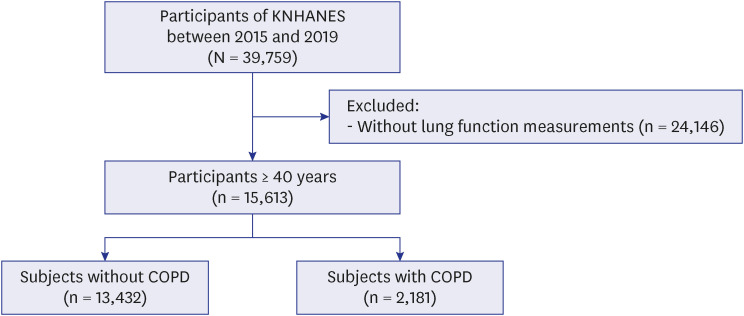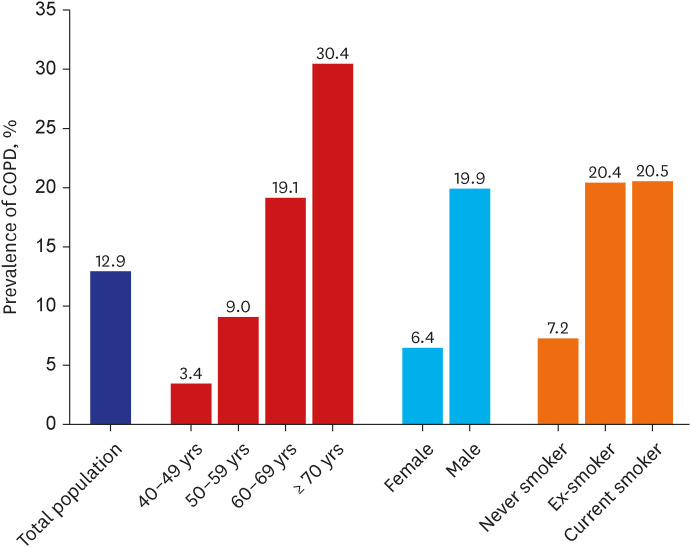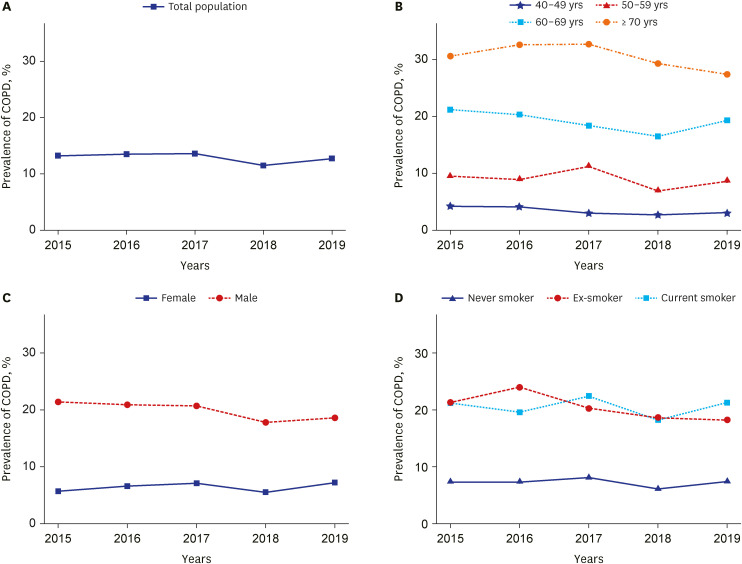J Korean Med Sci.
2023 Apr;38(14):e108. 10.3346/jkms.2023.38.e108.
Recent Prevalence of and Factors Associated With Chronic Obstructive Pulmonary Disease in a Rapidly Aging Society: Korea National Health and Nutrition Examination Survey 2015–2019
- Affiliations
-
- 1Division of Pulmonary, Allergy, and Critical Care Medicine, Department of Internal Medicine, Dongguk University Gyeongju Hospital, Dongguk University College of Medicine, Gyeongju, Korea
- 2Division of Pulmonary, Allergy, and Critical Care Medicine, Department of Internal Medicine, Hallym University Kangnam Sacred Heart Hospital, Hallym University College of Medicine, Seoul, Korea
- 3Division of Pulmonary Medicine and Allergy, Department of Internal Medicine, Hanyang University College of Medicine, Seoul, Korea
- 4Division of Pulmonary and Critical Care Medicine, Department of Internal Medicine, Konkuk University School of Medicine, Seoul, Korea
- 5Division of Pulmonary, Allergy, and Critical Care Medicine, Department of Internal Medicine, Seoul St. Mary’s Hospital, College of Medicine, The Catholic University of Korea, Seoul, Korea
- 6Division of Pulmonary, Allergy, and Critical Care Medicine, Department of Internal Medicine, Korea University Guro Hospital, Seoul, Korea
- 7Division of Pulmonary, Allergy, and Critical Care Medicine, Department of Internal Medicine, Hallym University Sacred Heart Hospital, Anyang, Korea
- 8Division of Pulmonary and Critical Care Medicine, Department of Internal Medicine, Seoul Metropolitan Government Seoul National University Boramae Medical Center, Seoul, Korea
- 9Division of Pulmonary, Allergy, and Critical Care Medicine, Department of Internal Medicine, Hallym University Kangdong Sacred Heart Hospital, Seoul, Korea
- KMID: 2541549
- DOI: http://doi.org/10.3346/jkms.2023.38.e108
Abstract
- Background
The prevalence of chronic obstructive pulmonary disease (COPD) increases with age, and aging is an important risk factor for COPD development. In the era of global aging, demographic information about the prevalence of and factors associated with COPD are important to establish COPD care plans. However, limited information is available in rapidly aging societies, including Korea.
Methods
We conducted a cross-sectional observational study using Korea National Health and Nutrition Examination Survey data from 2015–2019. We included 15,613 participants and analyzed trends of and factors associated with COPD.
Results
During the study period, the overall prevalence of COPD was 12.9%. Over five years, the yearly prevalence of COPD was fairly constant, ranging from 11.5% to 13.6%. Among individuals aged ≥ 70 years, nearly one-third met COPD diagnostic criteria. In the multivariable analysis, age 70 years or older was the most strong factor associated with COPD (adjusted odds ratio [aOR], 17.86; 95% confidence interval [CI], 14.16–22.52; compared with age 40–49), followed by asthma (aOR, 3.39; 95% CI, 2.44–4.71), male sex (aOR, 2.64; 95% CI, 2.18–3.19), and current smokers (aOR, 2.60; 95% CI, 2.08–3.25). Additionally, exsmokers, low income, decreased forced expiratory volume in 1 second %pred, and a history of pulmonary tuberculosis were associated with COPD. On the other hand, body mass index (BMI) ≥ 25 kg/m 2 (aOR, 0.62; 95% CI, 0.54–0.71; compared with BMI 18.5–24.9 kg/m 2 ) had an inverse association with COPD.
Conclusion
Recent trends in the prevalence of COPD in South Korea are relatively stable. Approximately one-third of participants aged 70 years and older had COPD. Aging was the most important factor associated with COPD.
Figure
Reference
-
1. Global Initiative for Chronic Obstructive Lung Disease (GOLD). Global Strategy for Prevention, Diagnosis and Management of COPD: 2023 Report. Updated 2023. Assessed December 6, 2022. http://goldcopd.org/2023-gold-report-2 .2. López-Campos JL, Tan W, Soriano JB. Global burden of COPD. Respirology. 2016; 21(1):14–23. PMID: 26494423.3. Chan KY, Li X, Chen W, Song P, Wong NW, Poon AN, et al. Prevalence of chronic obstructive pulmonary disease (COPD) in China in 1990 and 2010. J Glob Health. 2017; 7(2):020704. PMID: 29423187.4. Kim KW, Kim OS. Super aging in South Korea unstoppable but mitigatable: a sub-national scale population projection for best policy planning. Spat Demogr. 2020; 8(2):155–173. PMID: 34222615.5. Chang Y, Kang HY, Lim D, Cho HJ, Khang YH. Long-term trends in smoking prevalence and its socioeconomic inequalities in Korea, 1992–2016. Int J Equity Health. 2019; 18(1):148. PMID: 31533732.6. Song JH, Huh K, Chung DR. Modern history of tuberculosis in Korea. Infect Chemother. 2019; 51(4):414–426. PMID: 31782276.7. Shanmugasundaram K, Talwar A, Madan K, Bade G. Pulmonary functions and inflammatory biomarkers in post-pulmonary tuberculosis sequelae. Tuberc Respir Dis (Seoul). 2022; 85(2):175–184. PMID: 35232004.8. Kim DS, Kim YS, Jung KS, Chang JH, Lim CM, Lee JH, et al. Prevalence of chronic obstructive pulmonary disease in Korea: a population-based spirometry survey. Am J Respir Crit Care Med. 2005; 172(7):842–847. PMID: 15976382.9. Yoo KH, Kim YS, Sheen SS, Park JH, Hwang YI, Kim SH, et al. Prevalence of chronic obstructive pulmonary disease in Korea: the fourth Korean National Health and Nutrition Examination Survey, 2008. Respirology. 2011; 16(4):659–665. PMID: 21342331.10. Park H, Jung SY, Lee K, Bae WK, Lee K, Han JS, et al. Prevalence of chronic obstructive lung disease in Korea using data from the fifth Korea national health and nutrition examination survey. Korean J Fam Med. 2015; 36(3):128–134. PMID: 26019762.11. Yoo KH, Ahn HR, Park JK, Kim JW, Nam GH, Hong SK, et al. Burden of respiratory disease in Korea: an observational study on allergic rhinitis, asthma, COPD, and rhinosinusitis. Allergy Asthma Immunol Res. 2016; 8(6):527–534. PMID: 27582404.12. Hwang YI, Park YB, Yoo KH. Recent trends in the prevalence of chronic obstructive pulmonary disease in Korea. Tuberc Respir Dis (Seoul). 2017; 80(3):226–229. PMID: 28747954.13. Leem AY, Park B, Kim YS, Jung JY, Won S. Incidence and risk of chronic obstructive pulmonary disease in a Korean community-based cohort. Int J Chron Obstruct Pulmon Dis. 2018; 13:509–517. PMID: 29440888.14. Statistics Korea. Social Indicators in 2021. Updated 2023. Assessed September 12, 2022. http://kostat.go.kr/portal/eng/pressReleases/11/4/index.board?bmode=download&bSeq=&aSeq=418234&ord=1 .15. Kweon S, Kim Y, Jang MJ, Kim Y, Kim K, Choi S, et al. Data resource profile: the Korea National Health and Nutrition Examination Survey (KNHANES). Int J Epidemiol. 2014; 43(1):69–77. PMID: 24585853.16. Stanojevic S, Kaminsky DA, Miller MR, Thompson B, Aliverti A, Barjaktarevic I, et al. ERS/ATS technical standard on interpretive strategies for routine lung function tests. Eur Respir J. 2022; 60(1):2101499. PMID: 34949706.17. Lee H, Shin SH, Gu S, Zhao D, Kang D, Joi YR, et al. Racial differences in comorbidity profile among patients with chronic obstructive pulmonary disease. BMC Med. 2018; 16(1):178. PMID: 30285854.18. Grigsby MR, Siddharthan T, Pollard SL, Chowdhury M, Rubinstein A, Miranda JJ, et al. Low body mass index is associated with higher odds of COPD and lower lung function in low- and middle-income countries. COPD. 2019; 16(1):58–65. PMID: 31032662.19. Cao C, Wang R, Wang J, Bunjhoo H, Xu Y, Xiong W. Body mass index and mortality in chronic obstructive pulmonary disease: a meta-analysis. PLoS One. 2012; 7(8):e43892. PMID: 22937118.20. White HL, O’Campo P, Moineddin R, Matheson FI. Modeling the cumulative effects of social exposures on health: moving beyond disease-specific models. Int J Environ Res Public Health. 2013; 10(4):1186–1201. PMID: 23528813.
Article21. Mercado N, Ito K, Barnes PJ. Accelerated ageing of the lung in COPD: new concepts. Thorax. 2015; 70(5):482–489. PMID: 25739910.22. Hekimi S, Lapointe J, Wen Y. Taking a “good” look at free radicals in the aging process. Trends Cell Biol. 2011; 21(10):569–576. PMID: 21824781.23. Zhong S, Yang L, Liu N, Zhou G, Hu Z, Chen C, et al. Identification and validation of aging-related genes in COPD based on bioinformatics analysis. Aging (Albany NY). 2022; 14(10):4336–4356. PMID: 35609226.24. Houben JM, Mercken EM, Ketelslegers HB, Bast A, Wouters EF, Hageman GJ, et al. Telomere shortening in chronic obstructive pulmonary disease. Respir Med. 2009; 103(2):230–236. PMID: 18945604.
Article25. Morlá M, Busquets X, Pons J, Sauleda J, MacNee W, Agustí AG. Telomere shortening in smokers with and without COPD. Eur Respir J. 2006; 27(3):525–528. PMID: 16507852.26. Müller KC, Welker L, Paasch K, Feindt B, Erpenbeck VJ, Hohlfeld JM, et al. Lung fibroblasts from patients with emphysema show markers of senescence in vitro. Respir Res. 2006; 7(1):32. PMID: 16504044.
Article27. Savale L, Chaouat A, Bastuji-Garin S, Marcos E, Boyer L, Maitre B, et al. Shortened telomeres in circulating leukocytes of patients with chronic obstructive pulmonary disease. Am J Respir Crit Care Med. 2009; 179(7):566–571. PMID: 19179485.28. Tsuji T, Aoshiba K, Nagai A. Alveolar cell senescence in patients with pulmonary emphysema. Am J Respir Crit Care Med. 2006; 174(8):886–893. PMID: 16888288.29. United Nations. World population prospects: the 2008 revision. Updated 2009. Assessed September 12, 2022. https://www.un.org/development/desa/pd/content/world-population-prospects-2008-revision-volume-i-comprehensive-tables .30. United Nations. World population prospects 2022. Updated 2022. Assessed September 12, 2022. https://www.un.org/development/desa/pd/sites/www.un.org.development.desa.pd/files/wpp2022_summary_of_results.pdf .31. United Nations. World population prospects 2019. Updated 2019. Assessed September 12, 2022. https://www.un.org/development/desa/pd/news/world-population-prospects-2019-0 .32. Tanabe N, Sato S. Narrative review of current COPD status in Japan. J Thorac Dis. 2021; 13(6):3878–3887. PMID: 34277077.33. Blanco I, Diego I, Bueno P, Fernández E, Casas-Maldonado F, Esquinas C, et al. Geographical distribution of COPD prevalence in Europe, estimated by an inverse distance weighting interpolation technique. Int J Chron Obstruct Pulmon Dis. 2017; 13:57–67. PMID: 29317811.
Article34. Biener AI, Decker SL, Rohde F. Prevalence and treatment of chronic obstructive pulmonary disease (COPD) in the United States. JAMA. 2019; 322(7):602. PMID: 31429884.35. Jang IY, Lee HY, Lee E. 50th Anniversary Committee of Korean Geriatrics Society. Geriatrics Fact Sheet in Korea 2018 From National Statistics. Ann Geriatr Med Res. 2019; 23(2):50–53. PMID: 32743288.36. Rabe KF, Watz H. Chronic obstructive pulmonary disease. Lancet. 2017; 389(10082):1931–1940. PMID: 28513453.37. Choi JY, Milne S, Yunus F, Rhee CK, Matsunaga K. Current chronic obstructive pulmonary disease treatment status in asia: a position statement of the Asian Pacific Society of Respirology. Tuberc Respir Dis (Seoul). 2022; 85(3):279–282. PMID: 35501669.38. Global Initiative for Chronic Obstructive Lung Disease (GOLD). Global Strategy for Prevention, Diagnosis and Management of COPD. Updated 2023. Assessed September 12, 2022. https://goldcopd.org/2022-gold-reports-2 .39. Klotz U. Pharmacokinetics and drug metabolism in the elderly. Drug Metab Rev. 2009; 41(2):67–76. PMID: 19514965.40. Santos NC, Miravitlles M, Camelier AA, Almeida VD, Maciel RR, Camelier FW. Prevalence and impact of comorbidities in individuals with chronic obstructive pulmonary disease: a systematic review. Tuberc Respir Dis (Seoul). 2022; 85(3):205–220. PMID: 35618259.
Article41. Hanana NA, Foreman M, Sharafkhaneh A, Wise RA, Zhang L, DeMeo D, et al. Characteristics of Elderly COPD Patients in The COPDGene® Cohort. A42 COPD Phenotypes. New York, NY, USA: American Thoracic Society;2010. p. A1563.42. Dusser D, Calverley PM, Wise RA, Mueller A, Metzdorf N, Anzueto A. Clinical characteristics and outcomes of elderly patients with COPD: TIOSPIR® post-hoc analysis. Eur Respir J. 2016; 48(Suppl 60):PA4083.43. Buja A, Elvini S, Caberlotto R, Pinato C, Mafrici SF, Grotto G, et al. Healthcare service usage and costs for elderly patients with obstructive lung disease. Int J Chron Obstruct Pulmon Dis. 2020; 15:3357–3366. PMID: 33376316.44. Barbara S, Kritikos V, Bosnic-Anticevich S. Inhaler technique: does age matter? A systematic review. Eur Respir Rev. 2017; 26(146):170055. PMID: 29212836.45. Korean Statistical Information Service. Updated 2022. Assessed September 12, 2022. https://kosis.kr/statHtml/statHtml.do?orgId=101&tblId=DT_2KAAC04_OECD .46. Allen AM, Oncken C, Hatsukami D. Women and smoking: the effect of gender on the epidemiology, health effects, and cessation of smoking. Curr Addict Rep. 2014; 1(1):53–60. PMID: 27213132.47. Yang BY, Dong GH. Tobacco smoking in Asia-a public health threat. JAMA Netw Open. 2019; 2(3):e191471. PMID: 30924888.48. Fan H, Wu F, Liu J, Zeng W, Zheng S, Tian H, et al. Pulmonary tuberculosis as a risk factor for chronic obstructive pulmonary disease: a systematic review and meta-analysis. Ann Transl Med. 2021; 9(5):390. PMID: 33842611.49. Lee H, Sohn JW, Sim YS, Shin TR, Kim DG, Choi H. Outcomes of extended duration therapy for drug-susceptible cavitary pulmonary tuberculosis. Ann Transl Med. 2020; 8(6):346. PMID: 32355790.50. Abou Jaoude GJ, Garcia Baena I, Nguhiu P, Siroka A, Palmer T, Goscé L, et al. National tuberculosis spending efficiency and its associated factors in 121 low-income and middle-income countries, 2010-19: a data envelopment and stochastic frontier analysis. Lancet Glob Health. 2022; 10(5):e649–e660. PMID: 35427522.51. Grigsby M, Siddharthan T, Chowdhury MA, Siddiquee A, Rubinstein A, Sobrino E, et al. Socioeconomic status and COPD among low- and middle-income countries. Int J Chron Obstruct Pulmon Dis. 2016; 11:2497–2507. PMID: 27785006.52. Ntritsos G, Franek J, Belbasis L, Christou MA, Markozannes G, Altman P, et al. Gender-specific estimates of COPD prevalence: a systematic review and meta-analysis. Int J Chron Obstruct Pulmon Dis. 2018; 13:1507–1514. PMID: 29785100.53. Lange P, Celli B, Agustí A, Boje Jensen G, Divo M, Faner R, et al. Lung-Function trajectories leading to chronic obstructive pulmonary disease. N Engl J Med. 2015; 373(2):111–122. PMID: 26154786.54. Sun Y, Milne S, Jaw JE, Yang CX, Xu F, Li X, et al. BMI is associated with FEV1 decline in chronic obstructive pulmonary disease: a meta-analysis of clinical trials. Respir Res. 2019; 20(1):236. PMID: 31665000.55. Çolak Y, Afzal S, Nordestgaard BG, Lange P, Vestbo J. Importance of early COPD in young adults for development of clinical COPD: findings from the Copenhagen General Population Study. Am J Respir Crit Care Med. 2021; 203(10):1245–1256. PMID: 33142077.56. Çolak Y, Afzal S, Nordestgaard BG, Vestbo J, Lange P. Prevalence, characteristics, and prognosis of early chronic obstructive pulmonary disease. The Copenhagen General Population Study. Am J Respir Crit Care Med. 2020; 201(6):671–680. PMID: 31770495.57. van Dijk W, Tan W, Li P, Guo B, Li S, Benedetti A, et al. CanCOLD Study Group. Clinical relevance of fixed ratio vs lower limit of normal of FEV1/FVC in COPD: patient-reported outcomes from the CanCOLD cohort. Ann Fam Med. 2015; 13(1):41–48. PMID: 25583891.
- Full Text Links
- Actions
-
Cited
- CITED
-
- Close
- Share
- Similar articles
-
- Prevalence and socioeconomic burden of chronic obstructive pulmonary disease
- Recent Trends in the Prevalence of Chronic Obstructive Pulmonary Disease in Korea
- Effects of Aging and Smoking Duration on Cigarette Smoke-Induced COPD Severity
- Recent Advances in Molecular Basis of Lung Aging and Its Associated Diseases
- Chronic Obstructive Pulmonary Disease in Korea: Prevalence, Risk Factors, and Quality of Life




